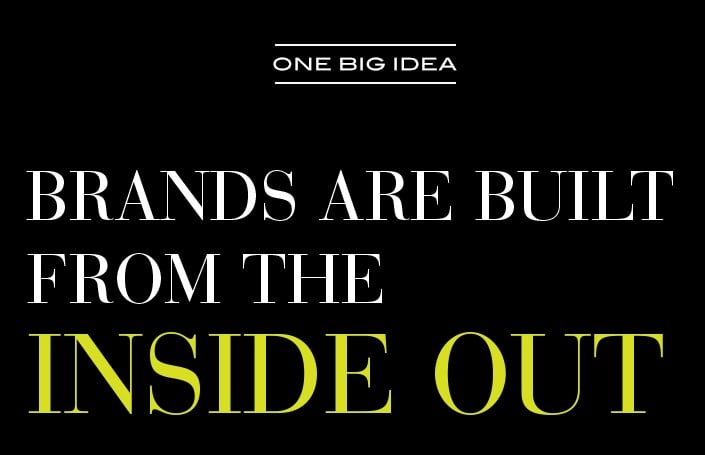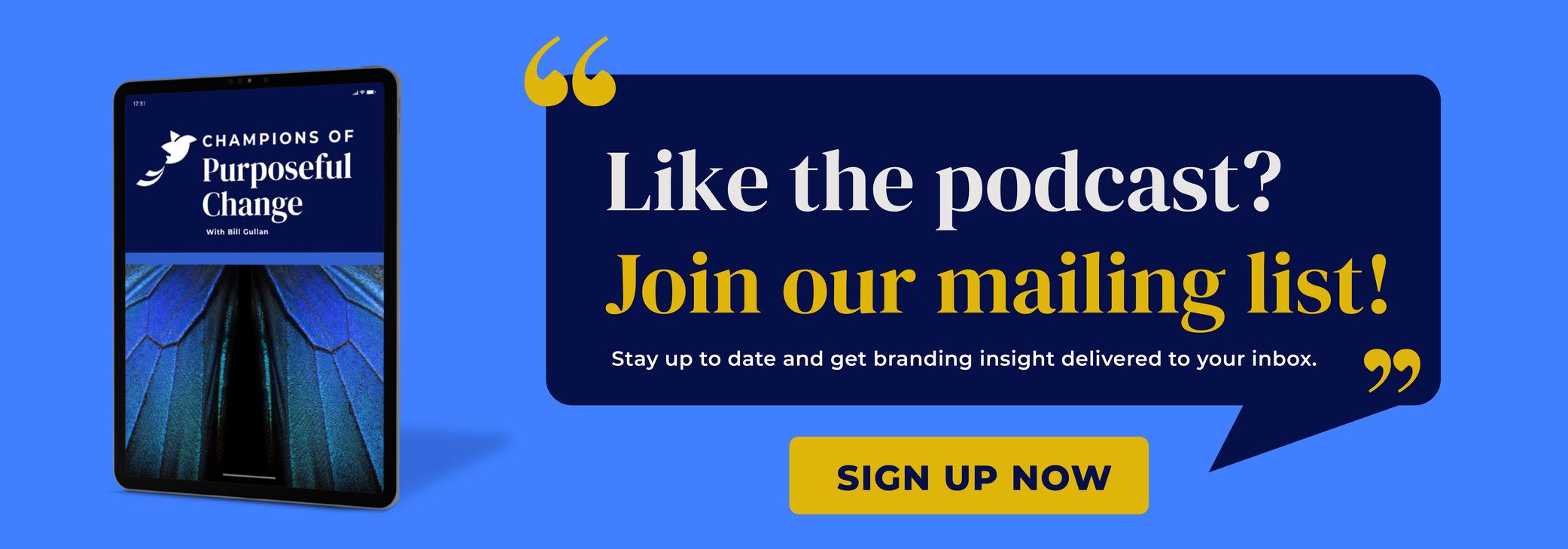One Big Idea: Brands are Built from the Inside Out

‘One Big Idea’ is a shorter episode of Real-World Branding, to be released in the week between our interviews. In this edition, Bill uses case studies to show how the strongest brands are built and delivered with a focus on the internal team. If you enjoy our podcast, please subscribe and leave us a review!
Podcast: Play in new window | Download Subscribe: iTunes | RSSTranscription
Welcome one and all, this is Real-World Branding. I’m your host, Bill Gullan, president of Finch Brands a premier, boutique branding agency, and this is One Big Idea. Today’s big idea is that Brands are Built from the Inside Out.
Our most recent interview was with Wil Reynolds, the founder and director of strategy at Seer Interactive, and one of the things we talked about was a branding or re-branding process that he and his team have recently undergone. One of the things that were notable about it was that it had really bubbled up from within the organization, the need and the potential to go through that process. We heard on an earlier podcast how Scott O’Neill, C.E.O. of the Philadelphia 76ers, New Jersey Devils etc., as an important part of his practice back when he was at Madison Square Garden Entertainment, internally developed a rule of three in terms of guiding principles and core values. That was something that he and the team developed together as a representation of their commitment, which certainly comes through in the way that their brand is perceived, sold, and everything else.
The best brands are built from the inside out for a couple of reasons, one is that the brand is often delivered via the efforts and the passions of human beings. Whether one is a retailer and has thousands of store associates who are interacting with customers or guests on a daily basis, they are carriers of the brand, they’re representations of the brand, or any organization that employs a sales force, any organization that has to write a bunch of different things over social media, sell sheets, or white papers, whatever it is, these are all human developed and it is impossible even with a smaller organization to control a message, to inspire folks to believe in and be passionate about a message, and to live successfully as embodiments, to be the brand unless the internal team, the team that is charged with carrying these things out, understands it, feels it, and models it day in and day out.
So a couple of examples, at least in our work, of how processes of brand development can be oriented to include and derive insight from, and then ultimately enroll, external teams in both brand creation and in the delivery of brand messages. We were working with a really amazing non-profit organization called KenCrest that is one of the leaders in the Mid Atlantic area in its field and the need was for a newly energized logo, tagline, and core communication. So it was a classic re-brand, although the name stayed intact. One of the things, to their credit and we’ve written about this on our blog, they realized that in order for this process to be effective and for all the goals to be achieved that their team really needed to be an important part of the process. KenCrest has over two thousand direct care staff who serve people with disabilities, across residential and workplace settings, and many different locations and group homes and different sized institutions. Direct care staff are the folks who are really on the ground, embodying what it means to be a part of the KenCrest team and thus embodying what KenCrest regards as special and different about itself.
We talked last week about how branding is about promise and about differentiation, there’s no point or moment where that ought to be more in evidence than when one interacts with a member of the field team – the direct care team at KenCrest. To their credit, another need is this work was getting done to undergo and facilitate a process of brand education and re-enrollment within an organization. Many of these folks have been there for a long period of time and really model the KenCrest brand every day, but there hadn’t been a lot of content around why, and what, and how, so we, in conjunction with our friends and clients at KenCrest, built a brand training program.
We used what we would call a ‘train the trainer’ technique where we develop the content and KenCrest chose probably forty out of that two thousand [team members] who would become trainers. They weren’t corporate trainers, their position wasn’t in education or training, they were just members of the team who happened to either have tenure, influence, were well liked, or understood the history and role of KenCrest. So we trained the trainers, these forty people, on brand education and then they fanned out across this organization and delivered this training, over the course of a month, to just about every single team member.
The way the training was built was for it to be a dialogue, it wasn’t just about ‘here are some slides, listen and take it.’ It was a dialogue within the KenCrest organization about what it meant to be a member of the KenCrest team – what were those core values that needed to be modeled, why KenCrest had decided to go through this process of re-branding, and what was the significance of some of the decisions that were made along the way. I think where KenCrest was left [after the process] was not only with all that they had hoped for in terms of extra communications on the re-branding side, but with a team that was energized, a team that understood why, a team that was ready to go out and take this message into the marketplace. Certainly when they were asked, ‘who is KenCrest’ they can answer but more importantly, they would live it, they would understand how to live it every single day.
One important element of the training was again not just about the logo or the tag line. What it was about was the history of the organization, its history of firsts when it comes to treating, supporting, and helping people with disabilities. So they were left with this kind of a three hundred sixty degree branding project that really put into practice this belief that brands are built from the inside out.
One more example before we close, in our work with our friends and clients at ThinkGeek, an organization that is by, of, and for those who are in touch with their inner geek – which we believe everyone has. Over time, they developed a very distinctive style of communicating on their e-commerce site, which is really the core of their business. It’s really important for them to maintain the trust and interest of their core customer that may be perceived as really enthusiastic for what they do. When you go to their headquarters you cannot help but take away a really solid sense of culture there. So when it became time to create brand content, it isn’t efficient to, whether you’re doing vision, mission, or positioning or whatever it is, tagline development [for instance], to have a couple hundred people in the room providing input, but it is important to create a mechanism whereby a team like this can be heard, can be heeded, and can feel really good about the outcome.
So in particular as we were building, in conjunction with ThinkGeek, their brand manifesto – the series of beliefs – we harvested ideas from the entire team, from our team, from the ThinkGeek management team etc. As we harvested the ideas we put them out, enabled voting on it, encouraged everyone to not only add their own ideas but to weigh in on those that had been developed by their peers, and ultimately the brand content that came out was not only great, we’re proud to say, but had been very strongly endorsed by and really created or co-created by the entirety of the ThinkGeek workforce.
So what they ended the process with was all the things they hoped for from an external communications standpoint, but also that receipt, that content was embraced, endorsed, and created by members of the team. So the culture was considered, not necessarily from an outside consultant only, but through the role of ThinkGeek team members in the process.
A couple of examples and there are obviously many more when you look at some of the most successful brands in the book, powerful brands, those that have reached the pantheon of being well understood. One of the factors they seem to have in common is that their workforce, while they may not use exactly the same words or repeat the same speech (they probably shouldn’t everyone has their own style), but often the attributes and elements of the core fabric and connective tissue of a brand are easily understood and modeled every day by teams. Whether it’s the folks that you meet when you go to the Apple store, other retailers, or other businesses that are just really well defined and well constructed.
So that’s the One Big Idea for this week, Brands are Built from the Inside Out. Hopefully it gives you the opportunity to think about how to effectively include members of the team and their insight into all the work that you do as it relates to brand development and management.
Before we sign off, three ways to help, as always, with Real-World Branding and with what we’re doing here with this podcast. We would love for you to subscribe, so it automatically flows in every single week into your device, you can do that through your podcast App Store of your choice. We’d love a rating, if we earned it, up to five stars. That’s what we strive for and rating this show, particularly rating highly, gives others a better opportunity to know that we’re out here – those who would find value in what we’re doing. And then the third thing, let’s continue to have great dialogue. The best way is on Twitter, @FinchBrands or directly to me @billgullan. Let’s keep the conversation going. All the best to you, signing off on the Cradle of Liberty, have a terrific day.





